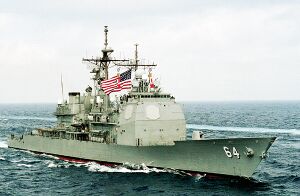Cruiser
US
- See also: Ticonderoga-class
Rationality returned on 30 Jone 1975. Guided missile frigates (DLG) all became either guided missile destroyers (DDG) or guided missile cruisers (CG). All the "destroyer leaders" except the Farragut/Coontz class were redesignated as guided missile cruisers:
- Virginia
- California
- Truxton
- Belknap
- Bainbridge
- Leahy
The Coontz Class was redesignated as Guided Missile Destroyers (DDG). "Frigate" changed from a term for a moderately large ship to the name of the "ocean escorts" that were "destroyer escorts" during WWII.
In 1980, the DDG-47 class were redesignated missile cruisers of the Ticonderoga class. The same hulls were also used for the Spruance-class land attack destroyers and the early Burke class air defense (and then multirole destroyers).
The first five did not have the Vertical Launch System (VLS) for missiles, and have all been retired. The remaining 22 are extremely powerful ships, although, in some respects, Burke class destroyers, which have had several "flights" or subclasses, may be more potent. "Ticos" are generally assumed to be escorts to carrier strike groups or expeditionary strike groups. In a carrier group, the overall group commander is usually aboard the carrier, while the group anti-air officer is apt to be on a Tico.
According to the US Navy, a cruiser had the principal mission of AAW, and was focused on providing air defense to an aircraft carrier. As well as having more VLS tubes, the Tico has an additional very-long-range air search radar that the Burke does not, and one more final missile guidance radar than a Burke. The latter are time-shared in any case, so either ship class can control more missiles than they have illuminators. With an AEGIS feature called Cooperative Engagement Capability (CEC), a given AEGIS system can guide SM-2 SAMs fired by other ships in the formation, so as long as a Burke had the Mark 99 launch control system working, it could fire SAMs "blind" and have another AEGIS vessel control them. Assuming the Burke also has CEC, however, the reverse could be true; the SAMs could be launched by a Tico and controlled by a Burke. In the Gulf War, the USS San Jacinto (CG-56), a Tico, was designated the "special weapons platform", carryin 122 Tomahawks. The normal Tico loadout is 12 Tomahawks and 110 SM-2.
Burkes definitely have more antisubmarine warfare capability than Ticos. It is not known if they carry VL-ASROC in their VLS and the Tico does not.
While both classes have VLS tubes that can launch Tomahawks, and the Ticos have more tubes, the Navy, perhaps in a reversal of roles, let the Burke take multiple roles. These roles are either carrier escort, or independent Tomahawk-shooter. The Burke, therefore, was made more survivable than the Tico, since Tomahawk launching needs little sensor help from the launching vessel. SM-2 and SM-3 SAMs and ABMs, however, must have the support of the full AEGIS system. Thus the DDG received a steel superstructure, increased blast overpressure resistance, more armor, a collective protection system and radar cross section reduction measures. Thus there is a historically anomalous situation of the destroyer being a more survivable ship than the cruiser. "[1]
